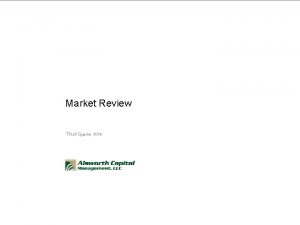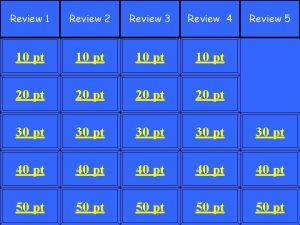2017 Annual Market Review 1 2017 Annual Market













- Slides: 13

2017 Annual Market Review 1

2017 Annual Market Review This report features world capital market performance for the past year. Overview: Market Summary World Asset Classes US Stocks International Developed Stocks Emerging Markets Stocks Select Country Performance Select Currency Performance vs. US Dollar Real Estate Investment Trusts (REITs) Commodities Fixed Income Impact of Diversification 2

Market Summary Index Returns Past performance is not a guarantee of future results. Indices are not available for direct investment. Index performance does not reflect the expenses associated with the management of an actual portfolio. Market segment (index representation) as follows: US Stock Market (Russell 3000 Index), International Developed Stocks (MSCI World ex USA Index [net div. ]), Emerging Markets (MSCI Emerging Markets Index [net div. ]), Global Real Estate (S&P Global REIT Index [net div. ]), US Bond Market (Bloomberg Barclays US Aggregate Bond Index), and Global Bond ex US Market (Citi WGBI ex USA 1− 30 Years [Hedged to USD]). The S&P data are provided by Standard & Poor's Index Services Group. Frank Russell Company is the source and owner of the trademarks, service marks, and copyrights related to the Russell Indexes. MSCI data © MSCI 2018, all rights reserved. Bloomberg Barclays data provided by Bloomberg. Citi fixed income indices © 2018 by Citigroup. 3

World Asset Classes 2017 Index Returns (%) Looking at broad market indices, emerging markets outperformed US and non-US developed markets in 2017. The value effect was negative in the US, non-US developed markets, and emerging markets. Small caps outperformed large caps in non-US developed markets but underperformed in the US and emerging markets. MSCI Emerging Markets Index (net div. ) 37, 28 MSCI Emerging Markets Small Cap Index (net div. ) 33, 84 MSCI World ex USA Small Cap Index (net div. ) 31, 04 MSCI Emerging Markets Value Index (net div. ) 28, 07 MSCI All Country World ex USA Index (net div. ) 27, 19 MSCI World ex USA Index (net div. ) 24, 21 S&P 500 Index 21, 83 Russell 1000 Index 21, 69 Russell 3000 Index 21, 13 MSCI World ex USA Value Index (net div. ) 21, 04 S&P Global ex US REIT Index (net div. ) 15, 64 Russell 2000 Index 14, 65 Russell 1000 Value Index 13, 66 Russell 2000 Value Index 7, 84 Dow Jones US Select REIT Index 3, 76 Bloomberg Barclays US Aggregate Bond Index 3, 54 One-Month US Treasury Bills 0, 80 Past performance is not a guarantee of future results. Indices are not available for direct investment. Index performance does not reflect the expenses associated with the management of an actual portfolio. The S&P data is provided by Standard & Poor's Index Services Group. Frank Russell Company is the source and owner of the trademarks, service marks, and copyrights related to the Russell Indexes. MSCI data © MSCI 2018, all rights reserved. Dow Jones data (formerly Dow Jones Wilshire) provided by Dow Jones Indices. Bloomberg Barclays data provided by Bloomberg. Treasury bills © Stocks, Bonds, Bills, and Inflation Yearbook™, Ibbotson Associates, Chicago (annually updated work by Roger G. Ibbotson and Rex A. Sinquefield). 4

US Stocks 2017 Index Returns The US equity market posted positive returns for 2017 but underperformed non-US developed and emerging markets. Value underperformed growth in the US across large and small cap indices. Ranked Returns for 2017 (%) Large Growth 30, 21 Small Growth 22, 17 Large Cap Small caps underperformed large caps in the US. 21, 69 Marketwide 21, 13 Small Cap 14, 65 Large Value Small Value 13, 66 7, 84 World Market Capitalization—US 52% US Market $27. 4 trillion Past performance is not a guarantee of future results. Indices are not available for direct investment. Index performance does not reflect the expenses associated with the management of an actual portfolio. Market segment (index representation) as follows: Marketwide (Russell 3000 Index), Large Cap (Russell 1000 Index), Large Cap Value (Russell 1000 Value Index), Large Cap Growth (Russell 1000 Growth Index), Small Cap (Russell 2000 Index), Small Cap Value (Russell 2000 Value Index), and Small Cap Growth (Russell 2000 Growth Index). World Market Cap represented by Russell 3000 Index, MSCI World ex USA IMI Index, and MSCI Emerging Markets IMI Index. Russell 3000 Index is used as the proxy for the US market. Frank Russell Company is the source and owner of the trademarks, service marks, and copyrights related to the Russell Indexes. MSCI data © MSCI 2018, all rights reserved. 5

International Developed Stocks 2017 Index Returns Looking at broad market indices, the value effect negative. Local currency Ranked Returns for 2017 (%) In US dollar terms, non-US developed markets outperformed the US market but underperformed emerging markets during 2017. was US currency 21, 34 Small Cap 31, 04 17, 87 Growth Small caps outperformed large caps in non-US developed markets. 27, 61 14, 63 Large Cap Value 24, 21 11, 62 21, 04 World Market Capitalization—International Developed 37% International Developed Market $19. 4 trillion Past performance is not a guarantee of future results. Indices are not available for direct investment. Index performance does not reflect the expenses associated with the management of an actual portfolio. Market segment (index representation) as follows: Large Cap (MSCI World ex USA Index), Small Cap (MSCI World ex USA Small Cap Index), Value (MSCI World ex USA Value Index), and Growth (MSCI World ex USA Growth). All index returns are net of withholding tax on dividends. World Market Cap represented by Russell 3000 Index, MSCI World ex USA IMI Index, and MSCI Emerging Markets IMI Index. MSCI World ex USA IMI Index is used as the proxy for the International Developed market. MSCI data © MSCI 2018, all rights reserved. 6

Emerging Markets Stocks 2017 Index Returns In US dollar terms, emerging markets outperformed the US and non-US developed markets for the year. Across the large cap and mid cap space, the value effect was negative; however, in the small cap space, the effect was positive. Local currency Ranked Returns for 2017 (%) US currency 39, 54 Growth 46, 80 30, 55 Large Cap Overall, small caps underperformed large caps in emerging markets. 37, 28 26, 38 Small Cap Value 33, 84 21, 84 28, 07 World Market Capitalization—Emerging Markets 12% Emerging Markets $6. 2 trillion Past performance is not a guarantee of future results. Indices are not available for direct investment. Index performance does not reflect the expenses associated with the management of an actual portfolio. Market segment (index representation) as follows: Large Cap (MSCI Emerging Markets Index), Small Cap (MSCI Emerging Markets Small Cap Index), Value (MSCI Emerging Markets Value Index), and Growth (MSCI Emerging Markets Growth Index). All index returns are net of withholding tax on dividends. World Market Cap represented by Russell 3000 Index, MSCI World ex USA IMI Index, and MSCI Emerging Markets IMI Index used as the proxy for the emerging market portion of the market. MSCI data © MSCI 2018, all rights reserved. 7

Select Country Performance 2017 Index Returns In US dollar terms, Austria recorded the highest country performance in developed markets with a gain of more than 50%, while Israel posted the lowest return for the year. In emerging markets, Poland China posted the highest country returns, each returning over 50%, while Pakistan and Qatar had the lowest performance. Ranked Developed Markets Returns (%) Austria Denmark Singapore Hong Kong Netherlands Italy Germany France Portugal Spain Japan New Zealand Switzerland UK Norway Ireland Finland Australia US Sweden Belgium Canada Israel Ranked Emerging Markets Returns (%) 51, 39 35, 40 34, 16 33, 95 33, 47 32, 02 30, 48 29, 53 28, 04 26, 58 25, 25 24, 76 24, 07 23, 70 23, 35 23, 29 21, 97 20, 94 20, 59 20, 51 19, 87 15, 62 10, 36 Poland China South Korea India Chile Peru Hungary Turkey Czech Republic Greece South Africa Thailand Taiwan Malaysia Brazil Philippines Indonesia Mexico Colombia Egypt Russia UAE Qatar Pakistan 53, 56 50, 67 46, 04 43, 72 43, 25 38, 95 38, 24 37, 84 37, 38 34, 98 33, 99 31, 46 30, 24 26, 80 26, 38 21, 53 19, 08 15, 01 14, 96 13, 65 5, 13 2, 25 -12, 79 -24, 75 Past performance is not a guarantee of future results. Indices are not available for direct investment. Index performance does not reflect the expenses associated with the management of an actual portfolio. Country performance based on respective indices in the MSCI World ex US IMI Index (for developed markets), MSCI USA IMI Index (for US), and MSCI Emerging Markets IMI Index. All returns in USD and net of withholding tax on dividends. MSCI data © MSCI 2018, all rights reserved. UAE and Qatar have been reclassified as emerging markets by MSCI, effective May 2014. 8

Select Currency Performance vs. US Dollar 2017 Index Returns Most developed market currencies appreciated against the US dollar in 2017. The euro and Danish krone appreciated the most with gains of almost 14%, while the Hong Kong dollar depreciated. In emerging markets, the Polish zloty and the Czech koruna appreciated more than 20%, while the Turkish lira depreciated over 7%. Ranked Developed Markets (%) Ranked Emerging Markets (%) Euro (EUR) 13, 85 Danish krone (DKK) 13, 70 Swedish krona (SEK) 10, 96 Israel shekel (ILS) 10, 86 British pound (GBP) 9, 48 Singapore dollar (SGD) 8, 10 Australian dollar (AUD) 8, 02 Canadian dollar (CAD) 7, 03 Norwegian krone (NOK) 5, 24 Swiss franc (CHF) 4, 29 Japanese yen (JPY) 3, 54 New Zealand dollar (NZD) Hong Kong dollar (HKD) 1, 99 -0, 82 Czech koruna (CZK) 20, 50 Poland zloty (PLZ) 20, 13 Hungary forint (HUF) 13, 36 South Korean won (KRW) 12, 82 Malaysian ringgit (MYR) 10, 85 South African rand (ZAR) 10, 46 9, 88 Thailand baht (THB) Chilean peso (CLP) 8, 91 Taiwanese NT dollar (TWD) 8, 30 Chinese yuan (CNY) 6, 72 Indian rupee (INR) 6, 33 Russian ruble (RUB) 6, 03 Mexican peso (MXP) 5, 30 Peru sol (PEI) 3, 47 Egyptian pound (EGP) 1, 97 Colombian peso (COP) 0, 59 Philippine peso (PHP) -0, 42 Indonesia rupiah (IDR) -0, 70 Brazilian real (BRC) Pakistani rupee (PKR) Turkish lira (TRY) -1, 88 -5, 41 -7, 23 Past performance is not a guarantee of future results. Indices are not available for direct investment. Index performance does not reflect the expenses associated with the management of an actual portfolio. MSCI data © MSCI 2018, all rights reserved. 9

Real Estate Investment Trusts (REITs) 2017 Index Returns Non-US real estate investment trusts outperformed US REITs in 2017. Ranked Returns for 2017 (%) Global REITs (ex US) US REITs 15, 64 3, 76 Total Value of REIT Stocks 42% World ex US $485 billion 251 REITs (23 other countries) 58% US $672 billion 101 REITs Past performance is not a guarantee of future results. Indices are not available for direct investment. Index performance does not reflect the expenses associated with the management of an actual portfolio. Number of REIT stocks and total value based on the two indices. All index returns are net of withholding tax on dividends. Total value of REIT stocks represented by Dow Jones US Select REIT Index and the S&P Global ex US REIT Index. Dow Jones US Select REIT Index used as proxy for the US market, and S&P Global ex US REIT Index used as proxy for the World ex US market. Dow Jones US Select REIT Index data provided by Dow Jones ©. S&P Global ex US REIT Index data provided by Standard and Poor's Index Services Group © 2018. 10

Commodities 2017 Returns The Bloomberg Commodity Index Total Return advanced 1. 70% in 2017. Ranked Returns for Individual Commodities (%) Aluminum was the strongest performer, posting a return of 29. 94%. Zinc and copper followed with respective returns of 28. 49% and 27. 95%. Natural gas was the weakest performer, falling 36. 97%. 29, 94 Zinc 28, 49 Copper 27, 95 Nickel 24, 40 Heating oil 13, 93 Brent oil 13, 17 Gold 11, 72 Cotton 11, 48 Live cattle 8, 11 Silver 4, 79 WTI crude oil 4, 11 Lean hogs 1, 83 Unleaded gas 1, 82 Soybean meal -5, 70 Soybean oil -7, 90 Soybeans -8, 99 Corn -12, 91 Wheat -13, 35 Kansas wheat -15, 73 Coffee Sugar -16, 81 -26, 08 Natural gas -36, 97 Past performance is not a guarantee of future results. Index is not available for direct investment. Index performance does not reflect the expenses associated with the management of an actual portfolio. All index returns are net of withholding tax on dividends. Securities and commodities data provided by Bloomberg. 11

Fixed Income 2017 Index Returns Interest rate changes across the US fixed income market were mixed during the fourth quarter. The yield on the 5 -year Treasury note rose 28 basis points (bps), ending at 2. 20%. The yield on the 10 -year Treasury note increased 7 bps to 2. 40%. The 30 -year Treasury bond yield decreased 12 bps to finish at 2. 74%. In terms of total returns, short-term corporate bonds declined 0. 04% during the quarter but increased 1. 85% for the year. Intermediate-term corporate bonds gained 0. 17% for the quarter and 3. 92% for the year. US Treasury Yield Curve (%) Bond Yields across Issuers (%) 4, 00 3, 02 42734 3, 00 43007 43098 2, 40 3, 36 2, 81 2, 00 1, 00 0, 00 1 Yr 5 Yr 10 Yr 30 Yr 10 -Year US Treasury Municipals AAA-AA Corporates A-BBB Corporates The total returns for short-term municipal bonds were – 0. 65% for the quarter and 1. 61% for the year. Intermediate-term municipal bonds fell 0. 09% for the quarter but gained 4. 70% for the year. Revenue bonds outperformed general obligation bonds for the year. One basis point equals 0. 01%. Past performance is not a guarantee of future results. Indices are not available for direct investment. Index performance does not reflect the expenses associated with the management of an actual portfolio. Yield curve data from Federal Reserve. State and local bonds are from the S&P National AMT-Free Municipal Bond Index. AAA-AA Corporates represent the Bank of America Merrill Lynch US Corporates, AA-AAA rated. A-BBB Corporates represent the Bank of America Merrill Lynch US Corporates, BBB-A rated. Bloomberg Barclays data provided by Bloomberg. US long-term bonds, bills, inflation, and fixed income factor data © Stocks, Bonds, Bills, and Inflation (SBBI) Yearbook™, Ibbotson Associates, Chicago (annually updated work by Roger G. Ibbotson and Rex A. Sinquefield). Citi fixed income indices © 2018 by Citigroup. ICE Bof. AML index data © 2018 ICE Data Indices, LLC. The S&P data are provided by Standard & Poor's Index Services Group. 12

Impact of Diversification 2017 Index Returns These portfolios illustrate the performance of different global stock/bond mixes. Mixes with larger allocations to stocks are considered riskier but have higher expected returns over time. Ranked Returns for 2017 (%) 100% Stocks 24, 62 75/25 18, 23 50/50 12, 14 25/75 100% Treasury Bills 6, 33 0, 80 Growth of Wealth: The Relationship between Risk and Return $120 000 Stock/Bond Mix 100% Stocks $100 000 $80 000 75/25 $60 000 50/50 $40 000 25/75 100% Treasury Bills $20 000 $0 12. 1988 12. 1993 12. 1998 12. 2003 12. 2008 12. 2013 12/2017 1. STDEV (standard deviation) is a measure of the variation or dispersion of a set of data points. Standard deviations are often used to quantify the historical return volatility of a security or portfolio. Diversification does not eliminate the risk of market loss. Past performance is not a guarantee of future results. Indices are not available for direct investment. Index performance does not reflect expenses associated with the management of an actual portfolio. Asset allocations and the hypothetical index portfolio returns are for illustrative purposes only and do not represent actual performance. Global Stocks represented by MSCI All Country World Index (gross div. ) and Treasury Bills represented by US One-Month Treasury Bills. Globally diversified allocations rebalanced monthly, no withdrawals. Data © MSCI 2018, all rights reserved. Treasury bills © Stocks, Bonds, Bills, and Inflation Yearbook™, Ibbotson Associates, Chicago (annually updated work by Roger G. Ibbotson and Rex A. Sinquefield). 13
 2017 dvhimss annual fall conference
2017 dvhimss annual fall conference American epilepsy society annual meeting 2017
American epilepsy society annual meeting 2017 Annual product review template
Annual product review template Sen annual review report example
Sen annual review report example Annual review of analytical chemistry
Annual review of analytical chemistry 21cfr211.180
21cfr211.180 Annual business review slide
Annual business review slide Annual review of pharmacology and toxicology
Annual review of pharmacology and toxicology Leader follower challenger nicher
Leader follower challenger nicher International segmentation
International segmentation Chapter review motion part a vocabulary review answer key
Chapter review motion part a vocabulary review answer key Ap gov review final exam review
Ap gov review final exam review Nader amin-salehi
Nader amin-salehi What is inclusion and exclusion criteria
What is inclusion and exclusion criteria

























